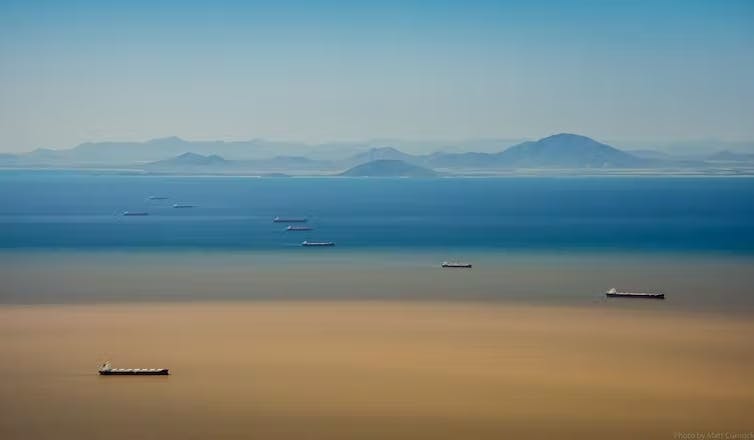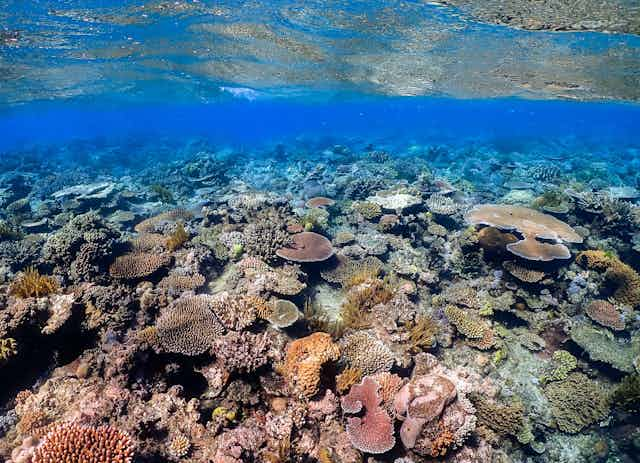You might be forgiven for thinking it’s Groundhog Day reading headlines about the Great Barrier Reef potentially being listed on the World Heritage “in danger” list. After all, there have been similar calls in 2012, 2013, 2014 and 2017.
Successive federal governments have lobbied hard to keep the largest coral reef in the world off the high-profile list kept by the United Nations Educational, Scientific and Cultural Organization (UNESCO).
Only last year, former environment minister Sussan Ley jetted around the world in a successful effort to stave off the inevitable, pointing to hundreds of millions of dollars spent on issues such as water quality. The new minister, Tanya Plibersek, also wants to avoid having the reef “singled out” in this way.
The question is, what does in-danger mean? Everyone knows the reef is in trouble. An in-danger listing is not a sanction or punishment. Rather, it’s a call to the international community that a World Heritage property is under threat, requiring actions to protect it for future generations. In-danger listing is not permanent, nor does it mean the Reef will be permanently removed from the World Heritage list.
The reef faces a multitude of threats. The most significant threats are coral bleaching worsened by climate change, poor water quality from land-based runoff, and unsustainable fishing and coastal development. We already have regulations to tackle many of them – but we need more effective enforcement to ensure compliance.

What just happened?
The Great Barrier Reef has been World Heritage listed since 1981. This means it’s considered an area of outstanding value to humanity. Covering an area the size of Italy, this iconic area includes some 3,000 separate reefs, over 1,000 islands and a variety of other significant habitats.
The latest UN mission has just reported back, finding the reef’s condition is worsening and recommending it be listed as “in danger”. It also offered practical solutions.
Previous governments have fought to ensure the reef is not listed as in-danger despite their own five-yearly reviews demonstrating an obvious decline. In 2009, the reef’s condition was rated poor and declining. In 2014 it was poor and declining and in 2019, very poor and declining.
So the government knows the reef is in danger. We know, and the tourism industry knows. While some tourism operators worry about their business, the opposite appears to be true: more people go, thinking it might be their last chance to see it. And already, operators are adapting by taking tourists to areas still in good condition.
Federal governments just don’t want the reef on the list because of the hit to their international reputation – and to their domestic standing.
If the reef is officially listed as “in danger” next year, it will draw a much greater focus to the reef’s plight. And that may help galvanise effective national and global action.
Take the case of the famous coral reefs of Belize in Central America. When these reefs were listed, the government banned nearby oil exploration and protected mangroves. Belize’s reefs have now been taken off the in-danger list.
Read more: Does tourism really suffer at sites listed as World Heritage In Danger?
So what has to be done?
The mission’s report lays out what needs to be done for the major issues.
Australia already has a long-term plan aimed at ensuring the reef’s sustainability. There are regulations governing, say, sediment and water quality in run off from agriculture and towns. We have some targets too, particularly around water quality.

The problem is delivery. There is a need to scale up efforts and improve compliance. Regulations mean very little if there’s ineffective enforcement. For example, while most farmers have taken on board the rules around fertiliser use, erosion and run-off, those flouting the rules get only a slap on the wrist. As the state government notes, enforcement is a “last resort”.
The UN mission has called on Australia to improve in four key areas:
1. Look after land and water
When native vegetation is cleared, it makes erosion more likely. Eroded soils are washed downstream and out to sea, where they can settle on coral and seagrass, smothering them. In Queensland, native vegetation is still being cleared at unsustainable levels.
2. Phase out gillnets
These long nets catch fish by their gills. But they also catch dugongs, dolphins and turtles, which then die. The UN mission made a very strong recommendation: phase out gillnets in the marine park.
3. More effective disposal of dredge spoil
Dredging shipping channels and ports produces a lot of silt and sand. If this is dumped in shallow areas, it can also spread to nearby corals and seagrass beds already under stress from climate change. A previous government policy ended the dumping of capital dredge spoil (dredging previously undisturbed areas). But maintenance dredge spoil is still being dumped at sea or used for reclamation, both causing adverse impacts.
4. Tackle climate change
This month, the northern reefs are sweltering in record water temperatures – raising the chance of further bleaching events. The UN report makes it clear that climate change is the biggest threat. Climate change heats up tropical waters, causing coral bleaching and potentially coral death. Australia, as one of the world’s top exporters of fossil fuels gas and coal, has long tried to go slow on climate action. The new government has moved to legislate a stronger 2030 emissions reduction target, but the UN report calls for even more ambition to keep warming under 1.5°C as this is widely accepted as the critical threshold for reef survival.
The report doesn’t make reference to the impacts of shipping on nearby coral and seagrass areas, such as sediment churned up by propellers of large ships and tankers.

Death by a thousand cuts
If you dive the reef for the first time this year, you might wonder if there really is a problem. After all, there are still fish and coral. When I first dove on the reef more than 35 years ago, it was in much better condition. What you see now may seem okay – but it’s a pale shadow of what it could or should be. It’s death by a thousand cuts.
As reef expert Professor Ove Hoegh-Guldberg has said:
The reef is in dire trouble, but it’s decades away before it’s no longer worth visiting. That’s the truth. But unless we wake up and deal with climate change sincerely and deeply then we really will have a Great Barrier Reef not worth visiting.
We’re never going to restore the reef to its pre-European conditions. But unless we take real action, future generations will wonder how and why we failed them so badly. We don’t need to wait for the World Heritage Committee to make in-danger listing to know the reef is in real trouble.

